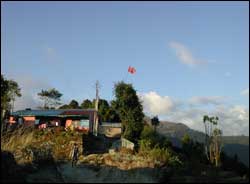 From talking to independent trekkers here in these scenic mountains north of Kathmandu, it seems people holidaying in Nepal are treating travel warnings with a grain of salt.
From talking to independent trekkers here in these scenic mountains north of Kathmandu, it seems people holidaying in Nepal are treating travel warnings with a grain of salt. "I don't want to sound irresponsible, but I have to say that nowadays there are so few adventurous tourist destinations left that are not on some sort of hit list," one Dutch tourist in Sermathang told us. She added, "It's been a couple of years since the travel warnings were upped for Nepal, but the fact remains that not a single tourist has been harmed as a result of the conflict."
In the villages above the Melamchi river, a scant one-day walk from Kathmandu, we wander through villages sporting Maoist flags fluttering from treetops. Anti-American graffiti denouncing the 'Royal American Army' adorn the walls of school building, and look like they are from another era, and another war. Other slogans: 'People's liberation is not terrorism', 'American Imperial Army Hands off Nepal'. The Maoists here seem to have run out of red paint, because the writings are all in fresh blue paint, the colour of peace.
Most trekkers we ran into in Helambu were prepared, rupees handy and sometimes even eager for an encounter, perhaps to provide them with added adventure for the slide show back home. "I am sure those were Maoists we saw on the trail today, did you see them?" one woman asked me at night in the lodge. They were actually the family of a sick young girl being carried down in a doko. But because they did not call out the customary 'namaste', were assumed to be Maoists. "I mean, what does a Maoist look like anyway?" another trekker asked me. She might have been surprised to know that sitting in the kitchen of the lodge that evening were three local Maoists.
In Gol Bhanjyang, locals said the local Maoist cadre leader had "enough money for now" and we would not have to part with any rupees. Two days later as we headed back to Kathmandu we awoke to a stream of army personnel sweating their way up the valley. Their undercover operatives had been sent through the area a couple of days earlier to gather intelligence on Maoist activity. What we were witnessing was a mopping-up operation. We walked one way, and the army went further up the valley. "All the Maoists disappeared now," the lodge owner said with a flick of his hand.
 Up on the Annapurna trail, there were similar stories last month. Trekkers on the trail were carrying souvenirs of Maoist receipts for 'donations'. "We had a fantastic time," two trekkers in Pokhara chirped enthusiastically. "You want to see our receipt?" They had been stopped in a lodge at Ghorepani, where one evening in mid-October, a couple of pleasant young chaps had come in asking for a donation.
Up on the Annapurna trail, there were similar stories last month. Trekkers on the trail were carrying souvenirs of Maoist receipts for 'donations'. "We had a fantastic time," two trekkers in Pokhara chirped enthusiastically. "You want to see our receipt?" They had been stopped in a lodge at Ghorepani, where one evening in mid-October, a couple of pleasant young chaps had come in asking for a donation. "They were polite enough to let us finish our dinners first and when we explained we were volunteers in Nepal. They said we should meet them later in another room downstairs," one of the trekkers said. They were given a 'special discount' rate, but still tried to explain to the young Maoists that they were not happy about the forced donation and that they should consider reclassifying the request. "Calling it a 'fee' would be better," they said.
The following day, after a hefty, hot climb to Damphus from Phedi, our own group were happily enjoying refreshments when another Canadian friend and her trekking group appeared. They had just spent two days walking the trail from Landruk through Tolka and Pothana where a large number of Maoists amassed in one of the villages.
"It was a schoolyard full of young Maoists being called out by name to come forward.comrade so and so, comrade so and so," she said. "They were all very young and this might explain why further up the valley I really noticed the absence of teenagers coming home at the end of the school day."
The following day, during the only day of action in the area so far, moving through the forest towards Damphus, the trekkers heard gunfire as the army began flushing out Maoists in the nearby jungles. Since then, this particular phase of activities in the Annapurna seems to be over, and the area has been quiet. The army presence is not so pronounced and Maoist extortion has tapered off.
My trekking clients often ask what they can do for Nepal when they get home to New Zealand. I simply ask that they put the situation into some sort of context that moves beyond the sensational headlines that have scared people off for the last few years. If tourism numbers this year are any indication, this seems to be working.
Wanda Vivequin is a Canada-based trekking group leader.


